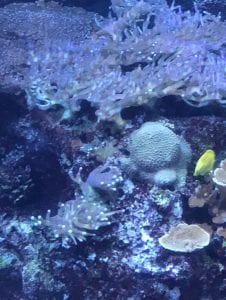April 22ndis Earth day, where we share our love for the wonderful planet we live on and raise awareness on how we can contribute to Earth more.

Via Giphy
Lately, much attention has been drawn on the awareness that global warming is occurring on our planet. This can have rippling effects on our planet, especially to small things such as zooxanthellae. As I mentioned in the previous post, zooxanthellae have a symbiotic relationship with coral reefs. The coral is the hosts of zooxanthellae, yet they rely on each other to survive. The coral is able to perform cellular respiration, creating carbon dioxide and water, which is given to the zooxanthellae. Using these products, the zooxanthellae are able to perform photosynthesis that creates sugars, oxygen, and lipids for the coral. Thus, zooxanthellae and coral reefs utilize each of the products they make, contributing to a continuous cycle and dependent on each other to survive. In terms of the zooxanthellae reproduction, the host coral is in charge of whether the new zooxanthellae stay or leave.
https://algaeresearchsupply.com/pages/how-do-coral-get-their-zooxanthellae
While the coral is in charge of this process, there is a possibility for the zooxanthellae to leave on their own will. This process is known as coral bleaching, a process that occurs when the zooxanthellae leave the coral due to not having the correct environment to function in. The corals become stressed by the changes in the environmental conditions causing it to expel the zooxanthellae. The main reasons as to why they leave consists of sudden extreme high or low temperatures in the water or changes in the light they are receiving. As the figure below explains, climate change, pollution, low tides, and too much sunlight stress out the coral leading to the bleaching of it.
https://oceanservice.noaa.gov/facts/coral_bleach.html
Once the coral loses its zooxanthellae, it begins to starve. Approximately 60- 70% of the zooxanthellae are lost when coral bleaching begins. In these cases, the coral has lost its source of nutrients, resulting in the corals losing its color and becoming white or pale, emphasizing the name coral bleaching.
Studies have shown that it is possible for corals to recover from the bleaching. If not too much time has passed by and the environment returns to normal conditions, zooxanthellae are able to return. However, if nothing changes and much time has passed since bleaching occurred, the coral will die. This is a sad process for the corals to deal with, and unfortunately, it is going to become more prominent if the climate changes or pollution does not stop. “In 2005, the U.S lost half of its coral reefs in the Caribbean in one year due to a massive bleaching event”. It was caused by the extremely high temperatures in the water that year. Since that year, the temperature is consistently increasing and drastically due to the harmful actions being done to the planet. Organizations such as Coral Restoration Foundation and SECORE foundation has partnered up with multiple aquariums, such as the Georgia Aquarium, to try and preserve the corals.
https://www.youtube.com/watch?v=KCQzfoi1gnI
Hopefully, we will be able to fight back and conserve the many wonderful corals our oceans have to offer. This is a reminder that we can all play a part in helping the corals by caring for the earth and giving it the love it deserves. By doing so, not only will we be able to preserve the corals, but also preserve our planet that needs our help

Via Giphy






















